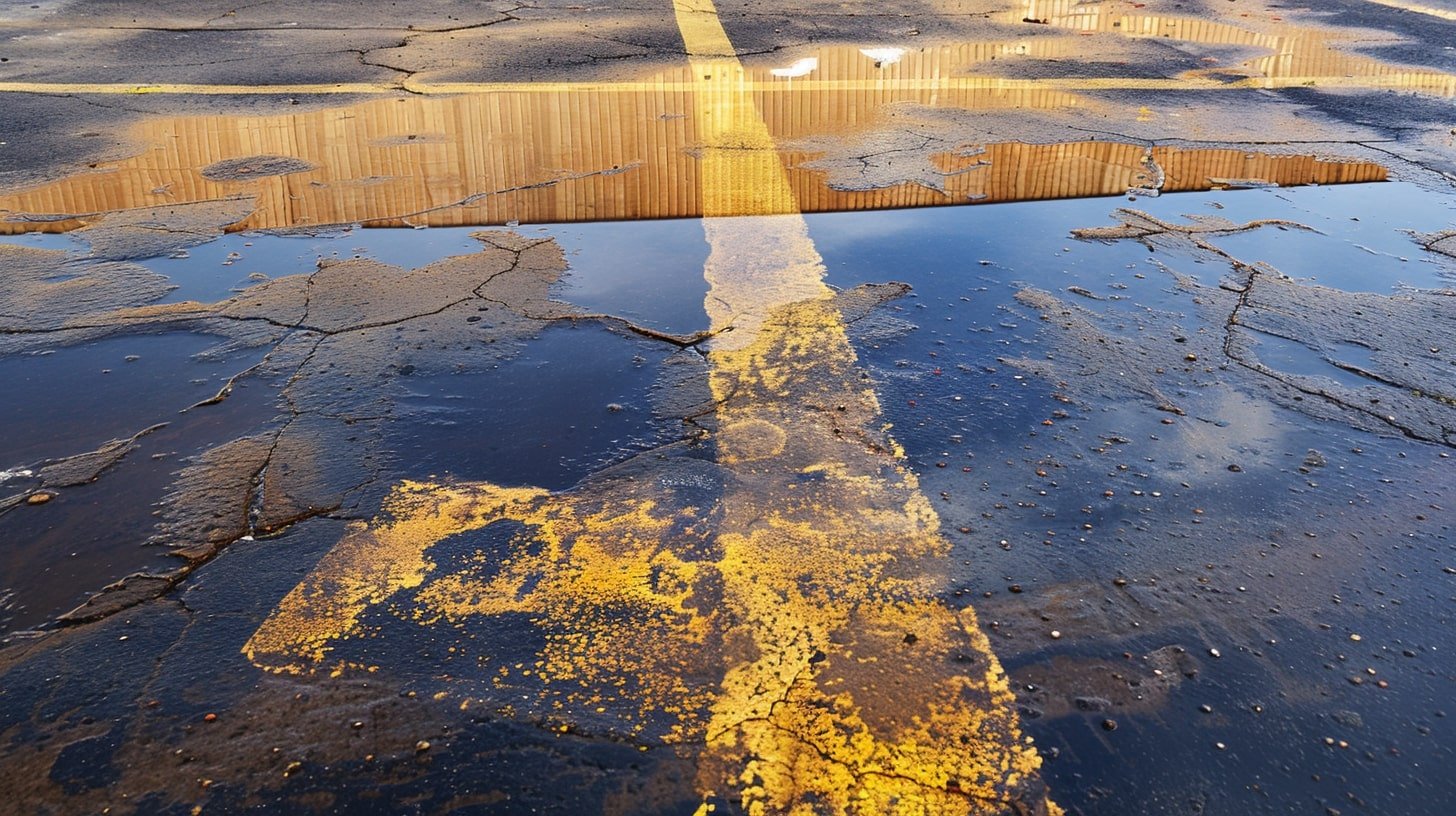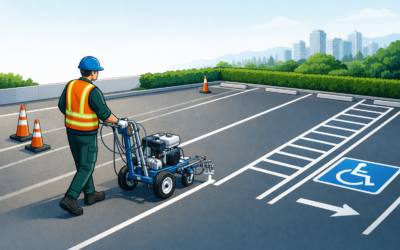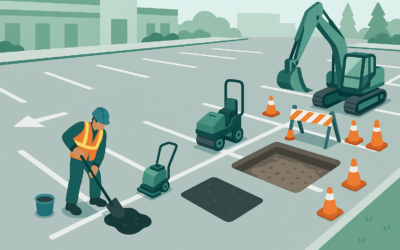Oil spots in parking lots are a common issue that most property owners have to deal with. These unsightly marks are caused by vehicles leaking oil, which then seeps into the surface of the asphalt or concrete. Over time, these spots can become more pronounced and harder to remove. But it’s not just about the looks—oil spots can also make the surface slippery and hazardous.
Table of Contents
Understanding the composition of these stains is essential for effective treatment. Oil spots are typically made up of petroleum-based fluids, including engine oil, transmission fluid, and other automotive lubricants. These substances are hydrophobic, meaning they repel water, which makes them difficult to clean with just soap and water.
To tackle oil spots effectively, you need specific methods and materials designed to break down and remove these stubborn stains.
Did you know? An average car can drip over 1 liter of fluids per year, which can lead to significant build-up if not addressed regularly.
Preparation Before Treating Oil Spots
Safety Measures
Before you start tackling those oil spots, safety should be your top priority. Cleaning oil spots involves handling chemicals and using tools that can pose risks if not used properly. Here are some key safety measures to keep in mind:
- Wear Protective Gear: Always wear gloves, safety glasses, and a long-sleeved shirt to protect your skin and eyes from chemicals and debris.
- Ventilation: If you’re working in an enclosed area like a parking garage, ensure there is adequate ventilation to avoid inhaling fumes from cleaning agents.
- Read Labels: Carefully read the labels on all cleaning products and follow the manufacturer’s instructions.
- Emergency Kit: Keep a first aid kit nearby in case of any accidents.
Assessing the Extent of Damage
Not all oil spots are created equal. Before you start the cleaning process, it’s crucial to assess the extent of the damage. This will help you determine the most effective treatment method. Here are some steps to follow:
- Inspect the Area: Walk around the parking lot and take note of all the oil spots. Identify which ones are fresh and which ones have been there for a while.
- Document the Damage: Take photos of the oil spots and make notes about their size and location. This will help you track your progress and see the effectiveness of your cleaning methods.
- Test a Small Area: Before applying any cleaning agent to a large area, test it on a small, inconspicuous spot to ensure it won’t damage the surface.
Important note: Old oil spots that have penetrated deep into the surface will require more intensive treatment methods compared to fresh spills.
Tools and Materials Needed
Having the right tools and materials is essential for effectively treating oil spots in parking lots. Here’s a list of items you’ll need:
- Absorbent Materials: Cat litter, sawdust, or baking soda can help soak up excess oil. Degreasers: Choose a high-quality degreaser specifically designed for oil stains.
- Scrub Brushes: Use stiff-bristled brushes to work the cleaner into the oil spot.
- Power Washer: For heavy-duty cleaning, a power washer can help blast away stubborn stains.
- Protective Gear: Gloves, safety glasses, and masks to protect yourself from chemicals.
- Buckets and Sponges: For applying and scrubbing cleaning solutions.
- Sealant: After cleaning, use a sealant to protect the surface from future oil spots.
Professional Techniques for Removing Oil Spots

Absorbent Materials
One of the first steps in treating oil spots is using absorbent materials to soak up as much oil as possible. Materials like cat litter, sawdust, or baking soda are excellent for this purpose. Here’s how to use them:
- Spread the Absorbent Material: Cover the oil spot completely with your chosen absorbent material.
- Let it Sit: Allow the material to sit on the oil spot for at least 30 minutes. For larger spills, you may need to leave it overnight.
- Sweep it Up: Use a broom and dustpan to sweep up the absorbent material. Dispose of it properly according to local regulations.
- Repeat if Necessary: For particularly stubborn spots, you may need to repeat the process. Using absorbent materials is a simple and cost-effective way to start the oil spot removal process. It helps to reduce the amount of oil that needs to be cleaned with harsher chemicals, making the entire process more efficient.
Degreasers and Cleaning Agents
Choosing the right degreaser is crucial for effective oil spot removal. Degreasers are designed to break down oil and grease, making it easier to clean. Here’s a step-by-step guide on how to use them:
- Choose the Right Product: Look for a degreaser that is specifically formulated for oil stains on asphalt or concrete. Some popular options include Simple Green, Purple Power, and Oil Eater. Apply the Degreaser: Spray or pour the degreaser directly onto the oil spot. Make sure to cover the entire area.
- Let it Sit: Allow the degreaser to sit for the amount of time specified on the product label. This usually ranges from 5 to 30 minutes.
- Scrub the Area: Use a stiff-bristled brush to scrub the oil spot. Apply firm pressure to work the degreaser into the surface.
- Rinse Thoroughly: Rinse the area with water. If you’re using a power washer, adjust the settings to avoid damaging the surface. Using degreasers can significantly improve the effectiveness of your cleaning efforts. Always follow the manufacturer’s instructions for the best results.
Power Washing
Power washing is one of the most effective methods for removing stubborn oil spots from parking lots. The high-pressure water can blast away oil and grime, leaving the surface clean and spotless. Here’s how to do it:
- Prepare the Power Washer: Set up your power washer according to the manufacturer’s instructions. Use a detergent specifically designed for use with power washers if needed.
- Adjust the Settings: Choose a medium pressure setting to start. High pressure can damage the surface, especially if it’s asphalt.
- Apply Detergent: If using a detergent, apply it to the oil spot and let it sit for a few minutes to break down the oil.
- Wash the Area: Hold the power washer nozzle about 12 inches from the surface and spray in a sweeping motion. Make sure to cover the entire oil spot.
- Rinse and Repeat: Rinse the area with clean water and check if the oil spot is gone. Repeat the process if necessary. Power washing is a quick and efficient way to tackle tough oil spots, but it’s important to use the right settings and techniques to avoid damaging the surface.
Advanced Treatment Methods
Steam Cleaning
Steam cleaning is an advanced method for removing oil spots that combines heat and pressure to break down and lift oil from surfaces. This technique is especially effective for deep-set stains.
Here’s how to use steam cleaning:
- Set Up the Steam Cleaner: Fill the steam cleaner with water and turn it on. Allow it to heat up to the recommended temperature.
- Apply Steam: Direct the steam nozzle at the oil spot and move it back and forth. The heat will help break down the oil while the pressure lifts it from the surface.
- Scrub if Needed: For particularly stubborn spots, use a brush to scrub the area while applying steam.
- Rinse and Dry: Rinse the area with clean water and let it dry. Repeat the process if necessary. Steam cleaning is a powerful and eco-friendly option for treating oil spots, as it uses only water and no chemicals.
Fun Fact: Did you know? Steam cleaning can reach temperatures of up to 150°C, which is hot enough to kill bacteria and other pathogens while cleaning the surface.
Chemical Treatments
Chemical treatments are another effective option for dealing with tough oil spots. These treatments involve using specialized chemicals that break down oil and grease. Here’s a guide on how to use chemical treatments:
- Choose the Right Chemical: Select a chemical cleaner that is specifically designed for oil stains. Ensure it is safe for the surface you are treating.
- Apply the Chemical: Follow the instructions on the product label. Apply the chemical directly to the oil spot.
- Let it Sit: Allow the chemical to work for the recommended amount of time.
- Scrub and Rinse: Use a brush to scrub the area and rinse it thoroughly with water.
Chemical treatments can be highly effective, but it’s important to handle them with care and follow all safety instructions.
Bioremediation
Bioremediation is a natural and environmentally friendly method for treating oil spots. It involves using microorganisms to break down and digest oil and grease. Here’s how to use bioremediation:
- Select a Bioremediation Product: Choose a product that contains oil-eating bacteria.
- Apply the Product: Follow the instructions on the product label. Apply it to the oil spot.
- Allow Time to Work: Bioremediation can take several days to several weeks, depending on the severity of the stain.
- Monitor Progress: Check the spot periodically to see the progress. Reapply the product if necessary. Bioremediation is a safe and sustainable option for treating oil spots, making it ideal for environmentally conscious property owners.
Preventive Measures to Avoid Future Oil Spots

Seal Coating
Seal coating is an effective preventive measure that helps protect parking lot surfaces from oil stains, water damage, and UV rays. Applying a seal coat creates a protective barrier, making it easier to clean up spills and extend the life of the pavement. Here’s a step-by-step guide on how to apply seal coating:
- Clean the Surface: Remove any debris, dirt, and existing oil spots from the parking lot. Use a power washer for a thorough clean.
- Fill Cracks and Holes: Repair any cracks and potholes using an asphalt patch or crack filler. This ensures a smooth surface for the seal coat.
- Mix the Seal Coat: Follow the manufacturer’s instructions to mix the seal coat. Some products may require you to add water or other additives.
- Apply the Seal Coat: Use a squeegee, brush, or spray system to apply the seal coat evenly across the surface. Work in small sections to ensure complete coverage.
- Allow to Dry: Let the seal coat dry according to the product’s instructions. This typically takes 24-48 hours.
- Reapply if Necessary: For added protection, consider applying a second coat once the first coat has dried completely.
Regular Maintenance Tips
Regular maintenance is key to preventing oil spots and keeping your parking lot in top condition. Here are some practical tips for maintaining a clean and oil-free parking lot:
- Perform Regular Inspections: Schedule routine inspections to identify and address oil spots and other issues early.
- Prompt Spill Cleanup: Clean up oil spills as soon as they occur to prevent them from soaking into the surface.
- Use Oil Absorbent Pads and Mats: Place absorbent pads or mats under vehicles that are prone to leaking oil. These can catch spills before they hit the pavement.
- Apply Seal Coating Regularly: Reapply seal coating every 2-3 years to maintain a protective barrier against oil stains.
- Educate Users: Inform parking lot users about the importance of reporting spills and leaks.
Using Oil Absorbent Pads and Mats
Oil absorbent pads and mats are practical tools for preventing oil spots in parking lots. These products are designed to soak up oil and other automotive fluids, making them ideal for use in high-traffic areas. Here’s how to use them effectively:
- Identify Problem Areas: Place absorbent pads or mats in areas where oil leaks are common, such as under parked vehicles or in loading zones.
- Choose the Right Product: Select pads or mats that are specifically designed to absorb oil. Some products are also resistant to water, which is ideal for outdoor use.
- Replace Regularly: Check the pads or mats regularly and replace them when they become saturated with oil.
- Dispose of Properly: Follow local regulations for disposing of used absorbent pads and mats. Some areas may have specific guidelines for handling oil-soaked materials.
Using oil absorbent pads and mats is a simple yet effective way to prevent oil spots and keep your parking lot clean and safe.
DIY vs. Professional Services
When to DIY
DIY methods for treating oil spots can be effective for small, manageable stains. They are cost-effective and can be done with readily available materials. Here’s when DIY is a good option:
- Small and Fresh Spills: If the oil spot is small and hasn’t penetrated deeply into the surface, DIY methods like using absorbent materials and household degreasers can be effective.
- Budget Constraints: DIY methods are generally cheaper than hiring professional services, making them a good option if you’re on a tight budget.
- Routine Maintenance: Regularly addressing small spills and performing preventive maintenance can keep your parking lot in good condition without the need for professional intervention.
DIY Steps:
- Absorb the Spill: Use cat litter or baking soda to absorb the oil.
- Apply a Degreaser: Spray a household degreaser on the stain and let it sit.
- Scrub and Rinse: Scrub the area with a brush and rinse with water.
Benefits of Hiring Professionals
While DIY methods can be effective for small spills, hiring professional services has several advantages, especially for larger and more stubborn oil spots:
- Expertise and Experience: Professionals have the knowledge and experience to tackle even the toughest oil stains using advanced techniques and specialized equipment.
- Efficient and Thorough: Professional cleaning services can complete the job more quickly and thoroughly than DIY methods, saving you time and effort.
- Long-Term Solutions: Professionals can provide treatments that not only remove existing stains but also protect the surface from future spills.
- Access to High-Quality Products: Professional services use industrial-grade cleaners and equipment that are more effective than consumer-grade products.
CityWideBC is Ready to Help Remove Oil Spots & Spills
If you’re in need of a professional parking lot maintenance company in the Lower Mainland of BC, City Wide can help!
Conclusion
Recap of Key Points
In this article, we’ve explored various professional techniques for treating oil spots in parking lots. From using absorbent materials and degreasers to power washing and advanced methods like steam cleaning and bioremediation, there are numerous effective strategies to address these unsightly stains. We’ve also discussed preventive measures such as seal coating, regular maintenance, and the use of oil-absorbent pads and mats.
Final Recommendations
To keep your parking lot in pristine condition, it’s essential to act promptly when dealing with oil spots. Whether you choose to tackle the stains yourself or hire professional services, following the right techniques and using the appropriate tools and materials will ensure the best results. Regular maintenance and preventive measures can also go a long way in protecting your investment.
Don’t let oil spots diminish the appearance and safety of your parking lot. Take action today to implement the methods discussed in this article. With the right approach, you can maintain a clean and attractive parking lot that enhances the value of your property.
FAQs
Can oil spots permanently damage my parking lot?
Yes, if left untreated, oil spots can penetrate deeply into the surface and cause long-term damage.
What is the best degreaser for oil spots?
Some popular choices include Simple Green, Purple Power, and Oil Eater, but it depends on the specific needs of your surface.
How often should I treat oil spots in my parking lot?
Regular maintenance is key. Address oil spots as soon as they appear to prevent them from becoming permanent.
Are there eco-friendly options for treating oil spots?
Yes, bioremediation and steam cleaning are environmentally friendly methods that effectively treat oil spots.
Can I prevent oil spots from occurring?
Yes, preventive measures like seal coating, using absorbent pads, and regular maintenance can help prevent oil spots.







